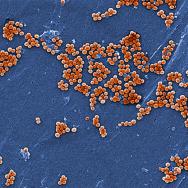Prof. Olaf Schneewind, one of the world’s leading authorities on the pathogenic bacteria that cause human disease, died May 26 after a long battle with cancer. He was 57 years old.
The Louis Block Professor and chair of the Department of Microbiology at the University of Chicago, Schneewind was a renowned expert on the pathogens Staphylococcus aureus, Bacillus anthracis (anthrax) and Yersinia pestis (the black plague)—and the mechanisms and strategies that enable them. Schneewind’s laboratory produced more than 250 peer-reviewed publications on the topic.
He had been working for 15 years on a vaccine that could neutralize the scourge of Staphylococcus aureus, including antibiotic-resistant strains. He often reminded students and colleagues, “Staphylococcus aureus is the infectious disease agent that causes the most morbidity and mortality in the 21st century in the United States.”
Schneewind was highly respected by his colleagues in the United States and abroad.
“I admired and respected the quality of his science as well as the practical, honest and straightforward way in which he approached problems,” said Kenneth Polonsky, dean of the Biological Sciences Division at the University of Chicago. “His outstanding scientific discoveries leave a significant impact on the field.”
One of Schneewind’s major accomplishments was his central role in the discovery of bacterial sortases. These enzymes help assemble proteins in specific bacteria and anchor these surface proteins to the cell wall. Sortases enable bacteria to adhere to other bacterial or animal cells. Without sortases and their surface protein substrates, bacteria such as Staphylococcus aureus cannot cause disease or interact with their environment.
The activity of the sortase enzyme was discovered in the early 1990s by Schneewind and coworkers before the gene coding for the enzyme was identified. By understanding sortase activity, Schneewind and colleagues (including his scientific collaborator and wife, Prof. Dominique Missiakas) were able to identify the surface proteins of other bacterial pathogens based on genome sequences and to study these molecules for their contributions to disease establishment as well as for vaccine development. These insights allowed the team to learn how these bacteria evade detection by the immune system.
Born in Germany, Schneewind earned his bachelor of science and his degree in medicine at the University of Cologne. He came to the United States as a postdoctoral fellow at Rockefeller University, where he worked in the laboratory of bacteriology and immunology led by Vincent Fischetti.
In 1992, he joined the faculty at the University of California, Los Angeles as an assistant professor of microbiology. In 2001, he joined the faculty of the University of Chicago in the Department of Molecular Genetics and Cell Biology. In 2004 he was asked to serve as the first chair of the newly created Department of Microbiology.
From 2003 to 2014, Schneewind served as the principal investigator of the Great Lakes Regional Center of Excellence for Biodefense, a program supported by the National Institute of Allergy and Infectious Diseases. He was the key driver behind the National Institute of Health’s application and construction of the University of Chicago’s Howard T. Ricketts Laboratory, a Level 3 Biosafety facility based at Argonne National Laboratory.
“He was always the smartest and hardest-working person in the room,” said colleague Joseph Kanabrocki, head of biosafety at the University of Chicago. “Olaf was ‘holistically responsible’ about his science and how it was conducted,” he added. “He was devoted to the research, but he focused and insisted upon extensive safeguards for his colleagues and trainees."
Schneewind served as an editor for the Journal of Bacteriology and the Annual Review of Microbiology. Schneewind also earned multiple prestigious honors and awards. In 2018, he was elected to membership in the National Academy of Sciences. He was previously selected as a fellow of the American Association for the Advancement of Science and as a member of the American Academy of Microbiology.
He is survived by his wife Dominique Missiakas, a highly respected and valued member of the UChicago faculty; and their daughters Daphne, Chloe and Penelope.
—Adapted from a story that first appeared on the University of Chicago Medicine website.

